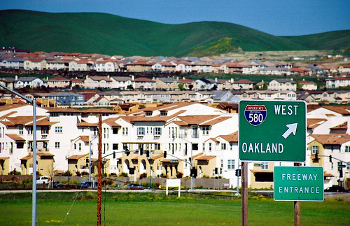More compact, multi-story housing brings all sorts of economic, quality of life, and environmental benefits. These include lower utility bills (including water), less maintenance on outdoor spaces, easier socializing, and vibrancy, to name a few.
But sometimes this type of housing can go horribly wrong. I call it “bad infill,” and it can undo almost all of the benefits you’d hope for from infill. For example, driving back from Monterey this past weekend, I drove through Morgan Hill, a suburban community on a commuter train line about 20 miles south of San Jose. I noticed a number of large, multifamily housing developments. However, not only were they visually unappealing (monolithic and cookie-cutter-ish), they were completely isolated and car-dependent.
Without a mix of uses nearby, as well as access to transit, these housing development lack the convenient walkable or bike-able access to destinations that a complete neighborhood should offer. Simply plopping down multifamily, dense housing without those key ingredients is a mistake that could undo all the environmental and economic benefits of infill.
We certainly need more housing, particularly in the major urban areas of California. But it has to be done right, to ensure we maximize car-free alternatives and convenience, quality of life, and beauty.
Otherwise, we risk engendering significant backlash to infill. In short, design, mix of uses, and location matters as much as compact housing.
Leave a Reply
You must be logged in to post a comment.



